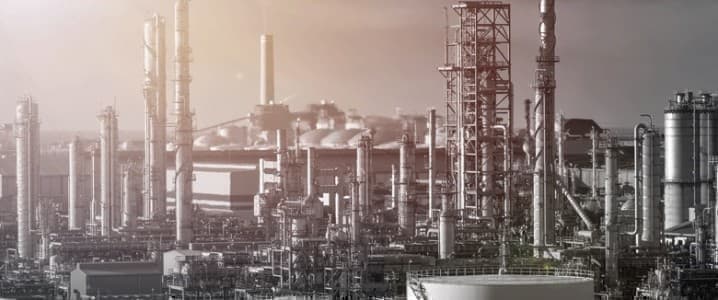When the oil markets go into a deadly tailspin as they have right now, sooner or later, everybody in the value chain starts to feel the heat keenly. Only three months into the year, oil and gas companies are trading at roughly half their valuations as the -49.5% YTD return by the Energy Select Sector Fund (XLE) portends, thanks to crude prices tanking to multi-decade lows.
It was only a matter of time before the shockwaves hit oil refineries, with the sector now sinking into the red.
Gasoline and jet fuel margins have plunged to their lowest levels in more than a decade with the double whammy of weak demand and crude oversupply, making for a perfect cocktail of a highly potent bear market.
New York Harbor RBOB Gasoline Front Month Futures

Source: Financial Times
Crack Spreads Fall

Source: CME
Gasoline crack spreads were already in freefall for six weeks, which accelerated after Saudi Arabia and Russia went into fisticuffs.
The RBOB (Reformulated Gasoline Blendstock for Oxygen Blending) Gasoline Crack for April futures plunged from $20.73/barrel on February 19 to a multi-year low of -$3.21 on March 24, about three weeks after Russia refused to curb its crude output and Saudi Arabia jacked up its output to full throttle at 12 million bpd.
NYMEX front-month RBOB vs. front-month NYMEX crack fell to -$6.06/b Monday, another multi-year low.
Meanwhile, Asian jet fuel refining margins turned negative for the first time in over a decade--hardly surprising as regional and international airlines remain grounded as the COVID-19 pandemic reaches fever pitch.
As reported by Reuters, Richard Gorry, managing director at JBC Energy Asia, says that global air traffic has declined 40-45% and will further deteriorate over the coming weeks as airline capacity reductions and more flight restrictions take effect. Gorry has warned that global jet/kero demand could fall by a whopping 70% quarter-on-quarter to just 2.5 million bpd as air passenger travel activity subsides to minimum levels.
Related: Oil Price Crash Opens A Window Of Opportunity For Renewables
Crack Spreads as a Demand Indicator Crack spreads serve as a real-time indicator of the demand for oil products.
Crack spread refers to the overall price differential between the price of a barrel of crude oil and the price of the petroleum products refined from it.
The “crack” is an industry term that refers to the process of breaking apart crude oil into different components, including gaseous products such as propane, heating fuel, gasoline, light distillates like jet fuel, heavy distillates like grease and intermediate distillates like diesel fuel.
The price of crude oil does not always perfectly align with the various prices of the products refined from it. Global supplies, weather fluctuations, and many other factors, especially the supply and demand for various distillates, result in pricing changes that directly impact profit margins for the refiner.
Crack spreads are essentially the economics of refining a barrel of crude oil into its constituent products and can be used as a proxy to gauge demand for various distillates.
When crack spreads move higher, it typically signals growing demand for oil products or falling crude prices, which translate into higher profit margins for refiners. Consequently, narrowing spreads tend to indicate weakening demand for refined products or rising crude prices, resulting in worsening margins for refiners.
Gasoline crack spreads tend to exhibit strong seasonality as they frequently decline during the winter months and move higher with increasing demand as spring and summer seasons approach. The current price action suggests softening demand mainly due to a seasonal weakness in gasoline.
But the current pandemic and oil price war have thrown a monkey wrench into the works, causing a disruption of epic proportions.
Negative crack spreads mean that refineries like Valero Energy Corp. (NYSE: VLO) and Marathon Petroleum Corp. (NYSE: MPC) are operating at a loss. It’s a clear signal for refiners to start cutting gasoline and jet fuel output.
Some have already responded to the signs of the times.
Related: Oil Climbs As U.S. Pushes For An End To The Price War
Phillips 66 (NYSE: PSX) has lowered its refinery rates at its Bayway refinery in New Jersey by as much as 20% while Trainer, Pennsylvania, has reduced rates by roughly the same margin.
Oil Demand Evaporates
Crack spreads have been improving over the past few days after the Senate unanimously approved a historic $2 trillion stimulus package to give a much-needed shot to the arm to the American economy during these difficult times.
But the rally could be short-lived. Why? Because it has since emerged that the U.S. Department of Energy suspended its plans to buy crude for the Strategic Petroleum Reserve after the requested $3 billion failed to make its way into the stimulus package.
The original request for proposal outlined plans to purchase the first 30 million barrels of American-made crude oil out of a total of 77 million barrels with a view to providing temporary relief for producers. The oil markets have been giving up their short-lived gains, with WTI crude shedding 4% to trade at $23.48 per barrel on Thursday.
An extremely dire oil demand outlook is not helping the situation.
The IEA has warned that global oil demand is likely to fall by a staggering 20 million bpd amid a global lockdown due to the coronavirus pandemic. With no end in sight for the oil price war between the oil-producing giants, things might get much worse for refiners before getting better.
By Alex Kimani for Oilprice.com
More Top Reads From Oilprice.com:
- Barclays Slashes Oil Price Forecast On Demand Shock
- Here’s Why Big Oil Stocks Are Rallying
- Saudi Arabia And The U.S. Could Form The World’s Newest Oil Cartel



















Don't these same entities own most of the companies that extract most of the crude oil out of the oil fields?
Don't most of these same entities own most of the companies transporting the crude oil from the fields to the refineries?